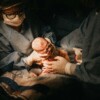
History and Presence
Todd C. Ream is Professor of Higher Education, Taylor University, and Distinguished Fellow, Excelsia College.
By almost any measure, Theodore Martin Hesburgh, C.S.C. (May 25, 1917 –February 26, 2015) was among the greatest university presidents of the twentieth century. Some historians may even go so far as to argue Hesburgh stands amongst the greatest university presidents in American history.
Perhaps one way to justify such seemingly audacious claims is to offer a quick review of the numbers, with the first and foremost being a tenure as the leader of the University of Notre Dame that not only spanned 35 years (1952-1987) but also arched across the most tumultuous era in the history of American higher education, the late 1960s through the early 1970s. While an inability to manage student unrest on their own campuses led to an unprecedented number of his contemporaries losing their positions, Hesburgh was a portrait of stability on the campus just north of South Bend, Indiana.
Stability, however, was far from the only quality Hesburgh offered Notre Dame, as other numbers also paint a portrait of unprecedented transformation. Among the most extraordinary numbers include the facts that during his tenure the university’s faculty grew from 350 to 950, student enrollment climbed from 4,979 to 9,600, the annual operating budget went from $9.7 million to $176 million, the endowment jumped from $9 million to $350 million, and funding for research soared from $735,000 to $15 million. Over 40 new buildings were also added on campus during his presidency, along with countless renovation projects.1
In 1972, Hesburgh also transformed the university by welcoming female students to the previously all-male campus. In 1967, he overhauled the university’s governance structure by creating a two-tiered board that welcomed laypersons among members of the Congregation of the Holy Cross who had led the institution since its founding by Edward Frederick Sorin, C.S.C. in 1842.
Just as significant as the impact Hesburgh had on the University of Notre Dame is the manner in which he contributed to ongoing debates of the mid- to late-twentieth century as a public intellectual. At a time when such intellectuals were reportedly disappearing, Hesburgh stepped forward as an active presence in debates surrounding issues such as science and technology, civil and human rights, and foreign relations and peace. At the core of his commitment to these issues was his vocation as a priest, a vocation forged by his participation in the Church’s sacraments.
Part of the challenge that comes in assessing Hesburgh’s legacy is cultivating a full appreciation for the way his vocation as a priest animated his efforts as an educational leader and a public servant. Modern historiographical means, however helpful, in the end fall short of capturing the full identity of any singular individual. With Hesburgh, the challenge that comes is the way such means fall short of capturing the full identity of someone who participated with regularity in the full presence of God.
At this juncture, Robert A. Orsi’s History and Presence offers a compelling argument for scholars who struggle to capture a fuller appreciation of the subjects they encounter than present methodologies offer. Orsi, Professor of Religious Studies and History and the Grace Craddock Nagle Chair in Catholic Studies at Northwestern University, seeks “to move beyond the static paradigm of normative ‘modern religion’” (3). In order to do so, Orsi believes, “we start with the Eucharistic debates of the sixteenth century, when the lineaments of the creation, ‘modern religion,’ first began to appear” (3-4).
Extending the impulse unleashed by the Protestant reformers, “modern theories of religion were written over accounts of the gods really present, submerging them in a rhetorical underworld, while on the surface the gods were reborn as symbols, signs, metaphors, functions, and abstractions” (4). Such theories in Orsi’s estimation are insufficient not only in terms of the subjects scholars seek to appreciate, but also because they bear witness to a history marked by a specific starting point and thus an attendant requisite of intellectual shortcomings.
Symbols, signs, metaphors, functions, and abstractions in their own way can echo God’s presence, but do so by accommodating that presence to palatable epistemological practices. Given this context, Orsi wants readers “to withhold from absence the intellectual, ethical, and spiritual prestige modernity gives it, and to approach history and culture with the gods fully present to humans” (8).
On one level, Orsi’s work demonstrates such theories are insufficient means for scholars to appropriate when seeking to fully appreciate subjects, Catholic and perhaps even some Protestants, whose identity is shaped by encounters with the presence of God. On another level, Orsi’s work offers plausible proposals for how scholars can employ means such as the “printed presence” to come to terms with what animates the lives of individuals such as Father Hesburgh.
In many ways, Orsi’s previous work points to what he unveils in History and Presence and, in addition, the autobiographical impulse woven into it. For example, debates concerning methodology were the focus of his most recent book, The Cambridge Companion to Religious Studies (New York: Cambridge University Press, 2011). In this work, Orsi stresses the lived dimensions of religious adherents and challenges scholars to discover ways to appreciate fully the worlds those adherents occupy.
In Between Heaven and Earth: The Religious Worlds People Make and the Scholars Who Study Them (Princeton, NJ: Princeton University Press, 2006), Orsi owns his Catholic identity and the ways that identity was shaped by some of his family members and their devotion to various saints. In various ways, Orsi took up this same challenge in his earliest books: Gods of the City: Religion and the American Urban Landscape (Bloomington, IN: Indiana University Press, 1999); Thank You, St. Jude: Women’s Devotion to the Patron Saint of Hopeless Causes (New Haven, CT: Yale University Press, 1998); and The Madonna of 115th Street: Faith and Community in Italian Harlem, 1880-1950 (New Haven, CT: Yale University Press, 1985).
History and Presence in many ways extends that argument but turns on the difference between methodological considerations framed by presence and absence. In addition, the autobiographical ramifications for the argument Orsi seeks to advance begin with the book’s very first line, “I have never known anyone with a deeper devotion to Christ in the Eucharist than my mother” (1). Believing such presence for adherents is real and can be at least more fully appreciated by scholars than previous methodological commitments allowed, Orsi then charts an interdisciplinary course for his readers focused on making an appreciation of individuals who live with a deep “devotion to Christ in the Eucharist” possible.
In order to fully deploy his argument and the various ways he argues such efforts are possible, Orsi steps back in his first chapter in an attempt to offer many of the details that point to his argument that the influence of Protestantism, over time, forged a methodological divide between presence and absence. In one sense, he frames the details that follow by arguing: “The destiny of Catholicism in the modern world, in other words, turns on the meaning of what Jesus said to his disciples at the Last Supper” (16). Orsi initially offers, “Luther held fast to the doctrine of the real presence,” but did so “to the great frustration and disappointment of his more radical contemporaries” (19). In particular, Orsi then focuses on Zwingli’s inability to “no longer imagine Christ to have said ‘this is my body’ with the literal meaning Luther attributed to it” (19).
Luther’s own understanding of consubstantiation would at least initially forge a path somewhere between Zwingli’s position and the transubstantiation of Catholicism. In another sense, Orsi argues that regardless of these differences, “the simple equation—Catholics = presence, Protestants = absence—was the caricature and polemical overstatement already in early modernity and remains so in the twenty-first century” (25).
The results of then equating absence with modernity even compelled “Catholic moderns [to] set about eliminating the abundance of lived devotional practices” (27). Presence no longer fit within the prevailing ways of knowing, and thus God’s presence, in time, went from being “a fearsome thing” to being a symbol, sign, metaphor, function, or abstraction (29).
Most of what follows in Orsi’s book seeks to capture various ways presence not only burst through the strictures modernity sought to place on it but also was honored by virtue of various methodological experiments. This shift begins in chapter 2, “Abundant History,” where Orsi addresses the persistent and diverse ways “vast crowds have gathered at the places on earth where the Mother of God had appeared, sometimes to single visionaries, at other times to groups of people” (48).
These appearances fostered devotion both for those who experienced the initial encounter and for individuals who traveled to the sites where the initial encounters took place. Longing for language sufficient to describe the experience that takes place for many at, for example, the Grotto of Lourdes, Orsi notes, “the boundaries of single subjectivities dissolve in fluid environments of desire, need, and hope, conscious and unconscious, in the Blessed Mother’s presence” (54).
Part of what makes such experiences a challenge for the methodological commitments defining modern scholarship is, according to Orsi, that
Human beings meet real presences in the midst of living their lives, but the purposes and intentions of the gods who come have yet to be discovered. These matters are not fully known in the encounter, nor are its consequences for the seers, their relationships, the future shape of their lives, or the world in which they live. (60-61)
The strictures of modern scholarship, as defined by the presumption that all that exists can be known and known in full, thus fall short of making sense of such encounters. Through these examples, Orsi proposes that “inquiry premised on a postulate of presence entails relinquishing the authority and control that adhere to the postulate of absence” (65). Toward the end of this chapter, he leaves his readers grappling with the possibility that “what is necessary is not writing, certainly not overwriting, but a kind of un-writing, to allow what is denied to break through” (65).
Wading further into this inextricably deconstructive and constructive exercise, Orsi argues in chapter 3 that “it is necessary to go below the surface of what is remembered and authorized” (72) in order to appreciate how three very different individuals experienced how “the transcendent broke into time” (92). Chapter 5 offers an examination of the “relationships between the living and the dying and the dead among Catholics in the United States in the twentieth century” and, in particular, does so by exploring the contours of the experience a young child and family shared as he passed from life to afterlife (163).
In chapter 6, Orsi walks alongside his mother and father as his mother battled colon cancer and, as a result, makes the argument that scholarship that values presence “entails risk, for the person whose world has been entered by the scholar, but for the scholar, too, whose own certainties ought to be on the line in the encounter” (213). Finally, chapter 7 unveils “the horrific proximity of evil to holiness” that surfaced during the priest sex abuse scandal (220). Testing his very thesis concerning presence, Orsi contends that such a form of proximity was “most publicly on display when a predator priest took God’s body in his hands and lifted it up to the congregation that included his victims” (220).
Orsi does not leave his readers with any easy answers in terms of how the methodology he is proposing might present in a manual for would-be inquirers. In contrast, he wants to open up space for such inquirers to begin to re-attune their sensibilities to the presence of God, embrace the kind of risk he proposed in chapter 6, and not flinch in the face of even the horrific proximity that evil and holiness can share as he details in chapter 7. God’s presence, by nature, as Orsi argues, will always slip over and above, around and even through such strictures. He wants scholars to “let the gods out of their assigned places and . . . approach history and religion through a matrix of presence” (251).
Perhaps one way to come to terms with what Orsi proposes as a matrix of presence is by wading into what he is asking and doing so by exploring his discussion of what he refers to as printed presence, a discussion he launches into in the book’s fourth chapter. Orsi makes the argument that “devotional print [in its various forms] was not simply a vehicle of ideas in this world; it was itself a medium of presence” (114). For example, printed works such as holy cards or prayer cards “strain toward an immediacy and intimacy in their depictions of Jesus, the Blessed Mother, and the saints, so that people came to think of them as almost photographs of the saints, to imagine that the saints really looked like this” (123).
Returning to Father Hesburgh, after he passed from life to afterlife, his body lay in repose in the Basilica of the Sacred Heart on the University of Notre Dame campus beginning at noon on Tuesday, March 3, 2015. The wake would take place that evening and thus halt the flow of well-wishers for a few hours. Regardless, by the time visitation came to an end at 10:00 AM the next day, more than 12,000 people passed by his casket and paid their respects.2 Each individual who did so was given the opportunity to leave sets of written remarks and take a prayer card with an image of Father Hesburgh on one side and his favorite prayer, “Come, Holy Spirit” on the other (see reproduction of the prayer card below). A funeral mass, burial, and memorial tribute would then follow on that Wednesday.
In the hands of some of Father Hesburgh’s well-wishers, that prayer card may be a reminder of a life well lived. The image of a collar-bearing priest with a gaze of firm devotion is explored in greater detail on the reverse side through the petition unto God to “fill the hearts of your faithful and kindle in them the fire of your love.”

In the hands of many others, that prayer card may offer something more. By encountering the gaze of a priest who awoke each day and met each challenge by asking God to “fill the hearts of your faithful and kindle in them the fire of your love,” such a prayer card, Orsi contends, acts as “a medium of presence.” No person would confuse Father Hesburgh with the one to whom the symbolic commitment of his collar and to whom the words of this prayer are offered. However, his life, and the tangible reminders on opposing sides of that prayer card harbor an iconic function. When operationalized within a culture of presence, “the movement of printed presence from hand to hand, life to life, does more than disclose the bonds among people; it creates them, intervenes in them, and reshapes them” (140).
The prayer cards offered to those 12,000 well-wishers are now in the hands of people who have, in many cases, scattered well beyond the Basilica of the Sacred Heart and the Notre Dame campus. One prayer card found its way into the Bible of someone who resides about 90 minutes south of the campus and who, as Orsi identified it, was raised in a culture of absence.
To pick up that card to this day is to receive a compelling invitation to consider what both of its sides have to offer, to reflect upon how one who submits to the obedience the collar represents is defined by praying, “Come, Holy Spirit.” Every act of picking up that card is an invitation to be reshaped in the image of the one to whom it points. One can only be left to wonder where else God’s presence resides and how methodological commitments, commitments defined by absence, compel so many of us to miss it.
The matrix of presence Robert A. Orsi proposes in History and Presence and the lives of individuals such as Father Hesburgh that it highlights prove to be beneficial guides for all would-be inquirers.4
Cite this article
Footnotes
- University of Notre Dame. “Key Events / Developments.” http://hesburgh.nd.edu/fr-teds-life/the-notre-dame-president/key-events-developments/. Accessed October 28, 2016.
- University of Notre Dame. “Visitation.” http://hesburgh.nd.edu/remembering-fr-ted/ visitation/. Accessed October 28, 2016.
- Used with permission of the University of Notre Dame.
- I would like to offer a special thanks to the Cushwa Center for the Study of American Catholicism for a grant that helped in the exploration of Robert A. Orsi’s History and Presence and its ramifications for a study of Father Hesburgh’s life and work. I also owe a special thanks to the University of Notre Dame for permission to reproduce the prayer card distributed during Father Hesburgh’s visitation.























